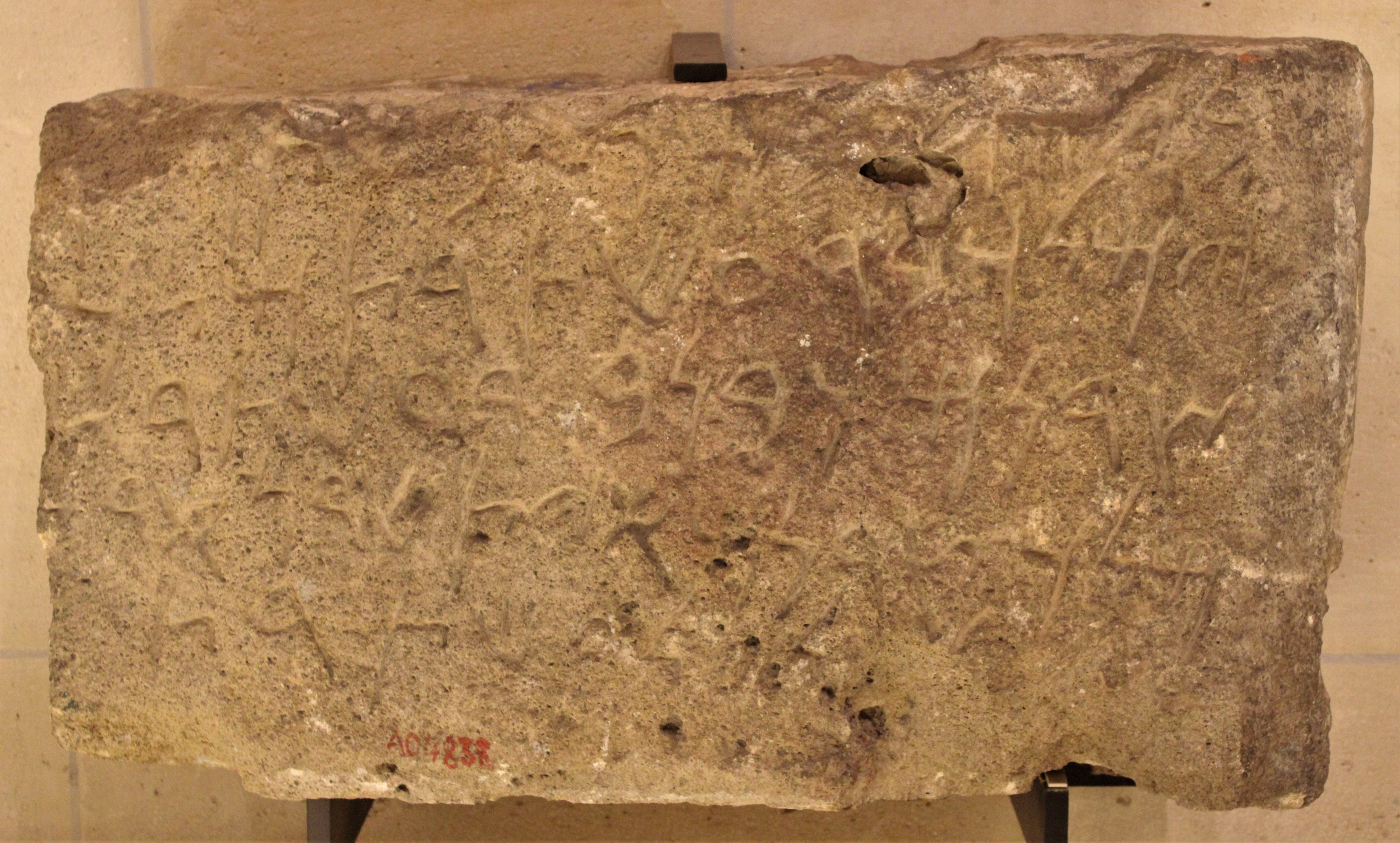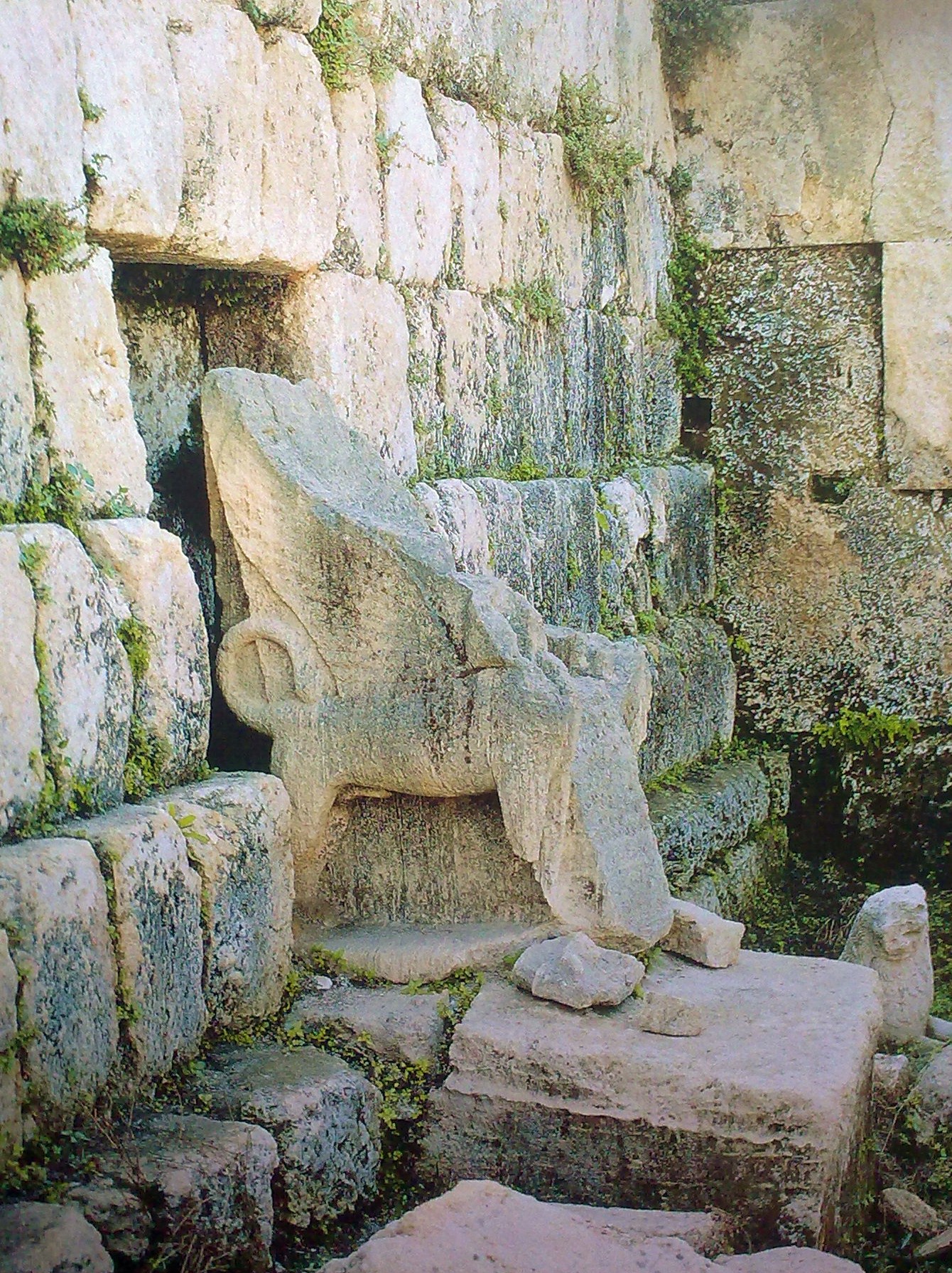|
Bodashtart
Bodashtart (also transliterated Bodʿaštort, meaning "from the hand of Astarte"; ) was a Phoenician ruler, who reigned as King of Sidon ( – ), the grandson of King Eshmunazar I, and a vassal of the Achaemenid Empire. He succeeded his cousin Eshmunazar II to the throne of Sidon, and scholars believe that he was succeeded by his son and proclaimed heir Yatonmilk. Bodashtart was a prolific builder, and his name is attested on some 30 eponymous inscriptions found at the Temple of Eshmun and elsewhere in the hinterland of the city of Sidon in Lebanon. The earliest discovered of Bodashtart's inscriptions was excavated in Sidon in 1858 and was donated to the Louvre. This inscription dates back to the first year of Bodashtart's accession to the throne of Sidon and commemorates the building of a temple to the goddess Astarte. The Temple of Eshmun podium inscriptions were discovered between 1900 and 1922 and are classified into two groups. The inscriptions of the first group, ... [...More Info...] [...Related Items...] OR: [Wikipedia] [Google] [Baidu] |
Bodashtart Inscriptions
The Bodashtart inscriptions are a well-known group of between 22–24 Phoenician inscriptions from the 6th century BC referring to King Bodashtart.Bordreuil, 1990, "L'exemple le plus impressionnant est certainement celui des nombreuses dedicaces de Bodachtart decouvertes dans le temple d'Echmoun pres de Saida et conservees aujourd'hui dans plusieurs musees, auxquelles s'ajoutent trois exemplaires demeures in situ... Le nombre des inscriptions de Bodachtart mises au jour et repertories est a ce jour d'au moins dix-neuf (KAI 15 + 16) dont neuf (KAI 16) mentionnent Yatonmilk patronyme de Bodachtart. Il faut y ajouter RES 767 K in situ et les trois mentionnes par G. Contenau, soit quatre, a moins que RES 767 K ne soit la premiere mentionnee par G. Contenau, ce qui reduirait le supplement a trois. De plus on ne sait si l'estampage de RES 289 C correspond a un exemplaire connu par ailleurs ou s'il est le seul temoignage d'un exemplaire aujourd'hui disparu. A ma connaissance le nombre d'ins ... [...More Info...] [...Related Items...] OR: [Wikipedia] [Google] [Baidu] |
Yatonmilk
Yatonmilk (, YTNMLK, Romanized also as Yatanmilk, Yaton Milk, Yatan-Milk) was a Phoenician King of Sidon and a vassal to the Achaemenid king of kings Darius I ( 515–486 BC).Elayi 2006, p.31 Epigraphic sources Yatonmilk's name was attested on many building stone-incised dedications dubbed the Bodashtart inscriptions that were found at the Temple of Eshmun in the hinterland of the city of Sidon in Lebanon. Despite being mentioned in the inscriptions, nothing is known about his reign due to the lack of further material or epigraphic evidence.Elayi 2018, p.234Kelly 1987, p.52 Bodashtart, Yatonmilk's father who is dubbed the 'builder king', carried out an extensive expansion and restoration project of the Temple of Eshmun; he left more than thirty dedicatory inscriptions at the temple site. The first phase of the works involved adding a second podium at the base of the temple.Elayi 2006, p.5 During this construction phase inscriptions were carved on the added podium's foun ... [...More Info...] [...Related Items...] OR: [Wikipedia] [Google] [Baidu] |
Temple Of Eshmun
The Temple of Eshmun ( ar, معبد أشمون) is an ancient place of worship dedicated to Eshmun, the Phoenician god of healing. It is located near the Awali river, northeast of Sidon in southwestern Lebanon. The site was occupied from the 7th century BC to the 8th century AD, suggesting an integrated relationship with the nearby city of Sidon. Although originally constructed by Sidonian king Eshmunazar II in the Achaemenid era ( 529–333 BC) to celebrate the city's recovered wealth and stature, the temple complex was greatly expanded by Bodashtart, Yatan-milk and later monarchs. Because the continued expansion spanned many centuries of alternating independence and foreign hegemony, the sanctuary features a wealth of different architectural and decorative styles and influences. The sanctuary consists of an esplanade and a grand court limited by a huge limestone terrace wall that supports a monumental podium which was once topped by Eshmun's Greco-Persian style marble t ... [...More Info...] [...Related Items...] OR: [Wikipedia] [Google] [Baidu] |
Eshmunazar II
Eshmunazar II ( Phoenician: 𐤀𐤔𐤌𐤍𐤏𐤆𐤓 ', a theophoric name meaning 'Eshmun helps') was the Phoenician King of Sidon (). He was the grandson of king Eshmunazar I, and a vassal king of the Achaemenid Empire. He reigned after his father Tabnit I on the throne of Sidon. He died at the premature age of 14, and was succeeded by his cousin Bodashtart. The king is known from his sarcophagus, decorated with two inscriptions in the Phoenician script. It is housed in the Louvre Museum. Etymology Eshmunazar is the Latinized form of the Phoenician theophoric name , meaning "Eshmun helps". Variable spellings include: ʾEšmunʿazor, ʾšmnʿzr, Achmounazar, Ashmounazar, Ashmunazar, Ashmunezer, Echmounazar, Echmounazor, Eschmoun-ʿEzer, Eschmunazar, Eshmnʿzr, Eshmunazor, Esmounazar, Esmunasar, Esmunazar, Ešmunʿazor, Ešmunazar, Ešmunazor. Chronology The absolute chronology of the Kings of Sidon from the dynasty of Eshmunazar I has been much discussed in the liter ... [...More Info...] [...Related Items...] OR: [Wikipedia] [Google] [Baidu] |
Eshmunazar I
Eshmunazar I ( Phoenician: 𐤀𐤔𐤌𐤍𐤏𐤆𐤓 ', a theophoric name meaning 'Eshmun helps') was a priest of Astarte and the Phoenician King of Sidon (). He was the founder of his namesake dynasty, and a vassal king of the Achaemenid Empire. Eshmunazar participated in the Neo-Babylonian campaigns against Egypt under the command of Nebuchadnezzar II or Nabonidus. The king is mentioned in the funerary inscriptions engraved on the royal sarcophagi of his son Tabnit and his grandson Eshmunazar II. The monarch's name is also attested in the dedicatory temple inscriptions of his other grandson, King Bodashtart. Etymology Eshmunazar is the Latinized form of the Phoenician theophoric name , meaning "Eshmun helps". Chronology The absolute chronology of the Kings of Sidon from the dynasty of Eshmunazar I has been much discussed in the literature; traditionally placed in the course of the fifth century, inscriptions of this dynasty have been dated back to an earlier per ... [...More Info...] [...Related Items...] OR: [Wikipedia] [Google] [Baidu] |
King Of Sidon
The King of Sidon was the ruler of Sidon, an ancient Phoenician city in what is now Lebanon. Scholars have pieced together the fragmented list from various archaeological finds since the 19th century. Egyptian period * c.1700s BC Zimrida * c. 1300s BC Zimredda of Sidon / Zimrida IISidon : a study in oriental history 1907, Appendix 1: Kings of Sidon, p. 155-156. * c. 1300s BC Iab-nilud Assyrian period * 680–677 BCPersian period Eshmunazar Dynasty * 575–550 BC |
Kings Of Sidon
The King of Sidon was the ruler of Sidon, an ancient Phoenician city in what is now Lebanon. Scholars have pieced together the fragmented list from various archaeological finds since the 19th century. Egyptian period * c.1700s BC Zimrida * c. 1300s BC Zimredda of Sidon / Zimrida IISidon : a study in oriental history 1907, Appendix 1: Kings of Sidon, p. 155-156. * c. 1300s BC Iab-nilud Assyrian period * 680–677 BCPersian period Eshmunazar Dynasty * 575–550 BC |
Kanaanäische Und Aramäische Inschriften
Kanaanäische und Aramäische Inschriften (in English, Canaanite and Aramaic Inscriptions), or KAI, is the standard source for the original text of Canaanite and Aramaic inscriptions not contained in the Hebrew Bible and Old Testament. It was first published from 1960 to 1964 in three volumes by the German Orientalists Herbert Donner and Wolfgang Röllig, and has been updated in numerous subsequent editions. The work attempted to "integrate philology, palaeography and cultural history" in the commented re-editing of a selection of Canaanite and Aramaic Inscriptions, using the "pertinent source material for the Phoenician, Punic, Moabite, pre-exile-Hebrew and Ancient Aramaic cultures." Röllig and Donner had the support of William F. Albright in Baltimore, James Germain Février in Paris and Giorgio Levi Della Vida in Rome during the compilation of the first edition. Editions The 4th edition was published between 1966-69, and a 5th edition was published in 2002. However, the 5t ... [...More Info...] [...Related Items...] OR: [Wikipedia] [Google] [Baidu] |
Phoenician Language
Phoenician ( ) is an extinct language, extinct Canaanite languages, Canaanite Semitic languages, Semitic language originally spoken in the region surrounding the cities of Tyre, Lebanon, Tyre and Sidon. Extensive Tyro-Sidonian trade and commercial dominance led to Phoenician becoming a lingua franca of the maritime Mediterranean Sea, Mediterranean during the Iron Age. The Phoenician alphabet History of the Greek alphabet, spread to Greece during this period, where it became the source of all modern Alphabet#European_alphabets, European scripts. The area in which Phoenician was spoken includes the northern Levant and, at least as a prestige language, Anatolia, specifically the areas now including Syria, Lebanon, parts of Cyprus and some adjacent areas of Turkey. It was also spoken in the area of Phoenician colonies, Phoenician colonization along the coasts of the southwestern Mediterranean Sea, including those of modern Tunisia, Morocco, Libya and Algeria as well as Malta, the we ... [...More Info...] [...Related Items...] OR: [Wikipedia] [Google] [Baidu] |
Josette Elayi
Josette Elayi-Escaich (; born 29 March 1943) is a French antiquity historian, Phoenician and Near-Eastern history specialist, and honorary scholar at the French National Center for Scientific Research (CNRS). Elayi authored numerous archaeology and history works, and literary novels. She is well known to the French public through her novels and for her calls for reform and activism against the CNRS research policy bias. In 2007 Elayi was decorated Knight of the Legion of Honor by the French state. Early life and education Josette Elayi née Escaich was born on 29 March 1943 in Les Bordes-sur-Lez, a small former commune now merged into Bordes-Uchentein in the Couserans (part of the Ariège department) in France's Pyrenees mountains. She studied in the nearby town of Saint-Girons. At the Saint-Girons high school, Elayi had an affinity for science and literature, but a skiing accident caused her to fall behind in science. Elayi recounts that "the literary course was much more ... [...More Info...] [...Related Items...] OR: [Wikipedia] [Google] [Baidu] |
Aqueduct (water Supply)
An aqueduct is a watercourse constructed to carry water from a source to a distribution point far away. In modern engineering, the term ''aqueduct'' is used for any system of pipes, ditches, canals, tunnels, and other structures used for this purpose. The term ''aqueduct'' also often refers specifically to a bridge carrying an artificial watercourse. Aqueducts were used in ancient Greece, ancient Egypt, and ancient Rome. The simplest aqueducts are small ditches cut into the earth. Much larger channels may be used in modern aqueducts. Aqueducts sometimes run for some or all of their path through tunnels constructed underground. Modern aqueducts may also use pipelines. Historically, agricultural societies have constructed aqueducts to irrigate crops and supply large cities with drinking water. Etymology The word ''aqueduct'' is derived from the Latin words (''water'') and (''led'' or ''guided''). Ancient aqueducts Although particularly associated with the Romans, aqueducts we ... [...More Info...] [...Related Items...] OR: [Wikipedia] [Google] [Baidu] |
Chronology Of The Bible
The chronology of the Bible is an elaborate system of lifespans, 'generations', and other means by which the Masoretic Hebrew Bible (the text of the Bible most commonly in use today) measures the passage of events from the creation to around 164 BCE (the year of the re-dedication of the Second Temple). It was theological in intent, not historical in the modern sense, and functions as an implied prophecy whose key lies in the identification of the final event. The passage of time is measured initially by adding the ages of the Patriarchs at the birth of their firstborn sons, later through express statements, and later still by the synchronised reigns of the kings of Israel and Judah. The chronology is highly schematic, marking out a world cycle of 4,000 years. The Exodus takes place in the year Anno Mundi 2666, exactly two thirds of the way through the four thousand years; the construction of Solomon's Temple is commenced 480 years, or 12 generations of 40 years each, after that ... [...More Info...] [...Related Items...] OR: [Wikipedia] [Google] [Baidu] |







